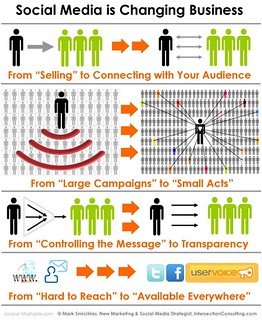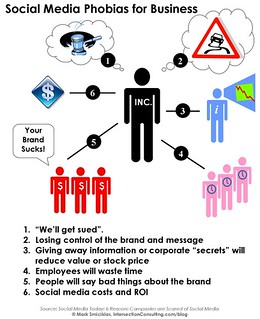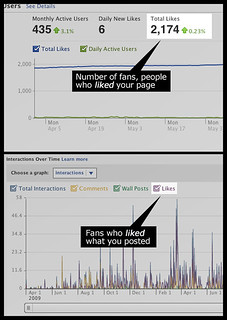By Hector Cisneros
 |
| Courtesy of Flickr |
When I looked at this particular business’ overall position, I
noticed it had done some things well, had done other things poorly, and some things
it had ignored altogether.
I created a short, one-page report and sent it to my broker friend
to see if their client was willing to meet and review the details of what I’d
found. I wanted to discuss how they could possibly address weaknesses in their
current program and take advantage of some opportunities I’d discovered.
They Had Developed a fan base of Over 4,000 Followers - a Pretty Good List
| English: Data from April 2011 Editor Survey that lists Social Media activities (Photo credit: Wikipedia) |
Two days later, my broker friend said their client felt they weren’t
ready to do anything right now. The broker's client complained their experience
with social media had produced very few sales, and that they didn’t want to
spend any money on improving their social media campaign, and wasn’t ready to
talk.
The reason I share this story is that it’s typical of the
kind of misunderstanding that most businesses have about how social media
works. Also, it shows how a business will focus on just one aspect of a
conversation, instead of taking in the big picture that was presented. I was
prepared to offer this client free insights about their strategic Internet presence,
but they were stuck on their lackluster foray into social media, which had not met
their expectations.
Today’s Internet marketing is made up of three sequential processes:
First, you have to be found. Second, you have to establish
credibility and trust. And third, you have to establish a method or message
that converts a visit to a sale. They normally happen in that order.
| Social Media: Changing Business (Photo credit: Intersection Consulting) |
Whether your marketing occurs in the search engines or social
media, all three steps must be completed. If you’re not being found, no one
will call, or click to buy your products or services. If no one trusts you,
your message or quality won’t matter. If your message is not compelling,
focused and easily understood, you will convert far fewer sales.
My broker friend’s client had focused on the fact they had only
received a handful of sales from his social media efforts. They did not take
the time to look at their overall strategic position. Most businesses expect
social media to produce direct sales, when, in fact, social media generally supports sales by building credibility. Social
media is best used in Step Two of the above-mentioned marketing process. Social
media normally doesn’t make sales directly (unless you’re using Pay Per Click [PPC]
in social media). The best way to understand social media is to think of it as
an electronic version of word-of-mouth marketing. People generally use social
media to find out who’s worth buying from. Social media works best when others sing
your praises, not when you toot your own horn.
Remember this rule: No one joined a social network to be sold to.
They joined to connect with people, find useful information, be entertained, or
learn something new.
Business owners will often say they posted special offers that talked
about how great their products or services are (that is, tooting their own horns),
with little or no sales to show for their efforts. Again, social media is not about
selling, it’s more about telling, sharing, and educating. It's about building trust,
and letting your customers’ word-of- mouth and positive feedback do the selling.
| Social Media Phobias (Photo credit: Intersection Consulting) |
For example, if you have a Facebook fan base of 4,000 followers, you’ve
developed a nice sized “fishing pond.” You’re now ready to fish. However, the bait
you use has to be special in this pond. You’ll want to encourage your fans to post
how wonderful your products are. Small inducements can be used; even a sincere thank
you can go a long way to getting their positive testimonials posted. Newcomers will
read their posts and will likewise believe your products or services are wonderful,
even though they’ve never tried them. They’re now more likely to buy your product
or service over a competitor’s. This method increases your credibility and often
leads to increased sales of your products or services.
Make Sure You're Measuring These Events
To ensure you can measure these events, make certain you provide a
unique offer, have an easy-to-find and easy-to-fill-out contact form , create a tracking
phone number, and/or require that new customers mention your timely special when
they make their purchase. Most of these tracking elements can be part of your
Fan or landing page. You can even couple the use of testimonials with PPC ads. In
Facebook, testimonials can be used as part of the ad copy in your PPC advertising
campaign. That’s right; the testimonials can actually be part of the ad, which then
can be tracked via your Facebook’s insight statistics.
Pay Per Click can be a direct sales method used in social media.
| Facebook Insights |
This method is “old school fishing” via ads that are run in the side
margins of your social media pages. PPC ads can generate direct sales, but they’re
far less effective without the testimonials. These PPC ads work only because of
the trust you’ve built with your customer base. If they didn’t trust you enough
to buy your products or services, they would’ve never tried it in the first place,
much less have recommended you in one of their posts. If you never received a
recommendation, you’d have a less effective ad. Again, the point is that social
media is more about building trust than selling. It’s chumming the water before you start fishing.
News Letter Need to Contain 90% Infotainment and 10% Sales Message
| EXIT 2012 January newsletter (Photo credit: Exit Festival) |
Once you’ve developed your fan base of a 1,000 + followers , (i.e.,
created your fishing pond), you’ll want to harvest their contact information so
you can connect with your fans and followers in more than one way. Email newsletters
can be very effective if you use a soft sales approach. Again, this type of marketing needs to be 90% credibility
building and 10% selling. You’ll need to provide useful and relevant information
that your followers want, need, and are interested in. The remaining 10% needs to
provide special offers, timely inducements or other enticements. Don’t just talk
about how great your product or service is, or that they need to buy your products
or services before the special ends. Give them a legitimate reason to buy
something. You’ll need to provide a way for your followers to opt out of your
email newsletters, if they so choose.
When my business broker friend told me their client hadn't received
but a dozen sales from their Facebook efforts, I wanted to ask the question: “Whose
fault was that?” I also wanted to ask that business owner if they had engaged their
followers in touch marketing in any way. I wondered how often they’d been sending
newsletters to their followers or posting coupons on their Facebook fan page. I
also wanted to ask if they’d been engaging their followers with contests or any
other social media methods. It would’ve been nice to know if they’d tried story
ads using testimonials in PPC. Given the poor results of this business’ non-existent
social media effort, the probable answers to any of the above questions was, “No,
I haven’t.”
I shared with my broker friend my analogy about Facebook and the fishing
pond. I explained how having a large Facebook fan base is similar to having one’s
own private pond that’s fully stocked with one’s favorite fish. “What your client’
did was take their boat out on their pond and demand that the fish jump into the
boat, just because it’s their pond,” I explained. Given the fact they had a dozen
customers buy something showed that some were ready to jump into the boat, even
though that business had used the wrong bait. Their Facebook fan base was a captive
audience that was ready to bite (that is, make a purchase) once they had earned
their trust and had treated them special.
In Order to Catch a Lot of Fish, You have to Use the Right Bait
| 'Gator Bait (Photo credit: Wikipedia) |
The reality was, this business person hadn’t fished in their pond properly.
They expected the fish (i.e., fans) to just jump in the boat. Like this business
owner, many others fail when trying to make social media work for them. A business
owner’s ignorance of how to fish in their private pond doesn’t mean the fish aren’t
biting. Those in business that want to catch fish (i.e. customers ) have to learn
the right bait to use, when the fish are hungry, and know the best time of day to
find the fish. In social media, you have to engage fans regularly, provide
useful infotainment, use the right inducement and the right message. You also have
to post your messages at the right time and in the right places so that your message
can be seen and acted on.
A Golden Rule for Social Networking: Quantity Matters!
| The Golden Rule (He who |
I want to end this story by mentioning the importance of the number
of fish in your pond. A Golden Rule for social networking is: quantity matters!
More is always better. The more followers, friends, or connections, the merrier.
Marketing to groups of less than 100 has no synergy. For social media to be effective,
you have to reach the first stage of critical mass. This means having at least 1,000
followers. The business person I’ve been discussing only had 27 Twitter followers
and no Google+ or LinkedIn followers. However, they had 4,000 Facebook fans. A
nice size fishing pond. “The Sales Rule of 10” can be applied to social networking
for determining effective group size. In other words, to reach 100 people quickly,
you have to have about 1,000 followers. The bottom line? Numbers matter. Sending
a message to a few hundred people won’t produce much of an impact. However, if you
send a message to 10,000 people, the odds are 1,000 will be reading it within minutes.
So understand my point: It’s not how big the network is (i.e. Facebook, Twitter,
etc.), it’s the number of followers you’re connected to that counts.
In this article, I discussed how developing a social network following
is similar to creating a fishing pond. I also talked about why social networks are
primarily used to build trust before you can generate sales. I pointed out the important
factors that determine success and what you have to do after you’ve developed a
large following.
 That's my opinion; I look forward to hearing yours.
That's my opinion; I look forward to hearing yours. If you like this article, you can find more by typing "Internet marketing" in the search box at the top left of this blog.
If you'd like a copy of our eBook, "Internet Marketing Tips for the 21st Century," please fill in the form below and we'll send you our free eBook. Your information is always kept
Hector Cisneros is a partner, COO and Social Media Director for the award-winning Working the Web to Win company, based in Jacksonville, FL. You can connect with him on Twitter, Facebook, Google+, LinkedIn, and YouTube. He’s also the co-host of Blog Talk Radio’s “Working the Web to Win,” where he and Working the Web to Win’s co-founder, Carl Weiss, make working the web to win simple for every business. Additionally, Hector is a syndicated writer for
Related articles








This is very informative. Both the analogy and instructive verbiage are helpful.
ReplyDeleteWhen it comes to turning clicks into cash online, the devil is in the details.
ReplyDeleteThis SITE is information is so clear,
ReplyDeleteadvertise online free